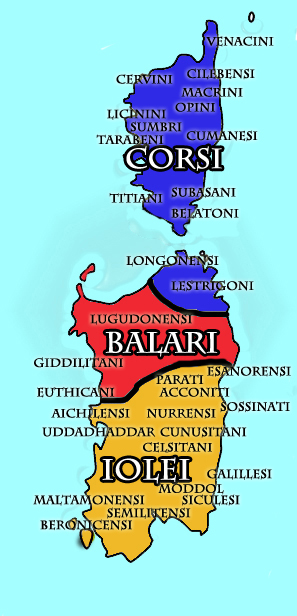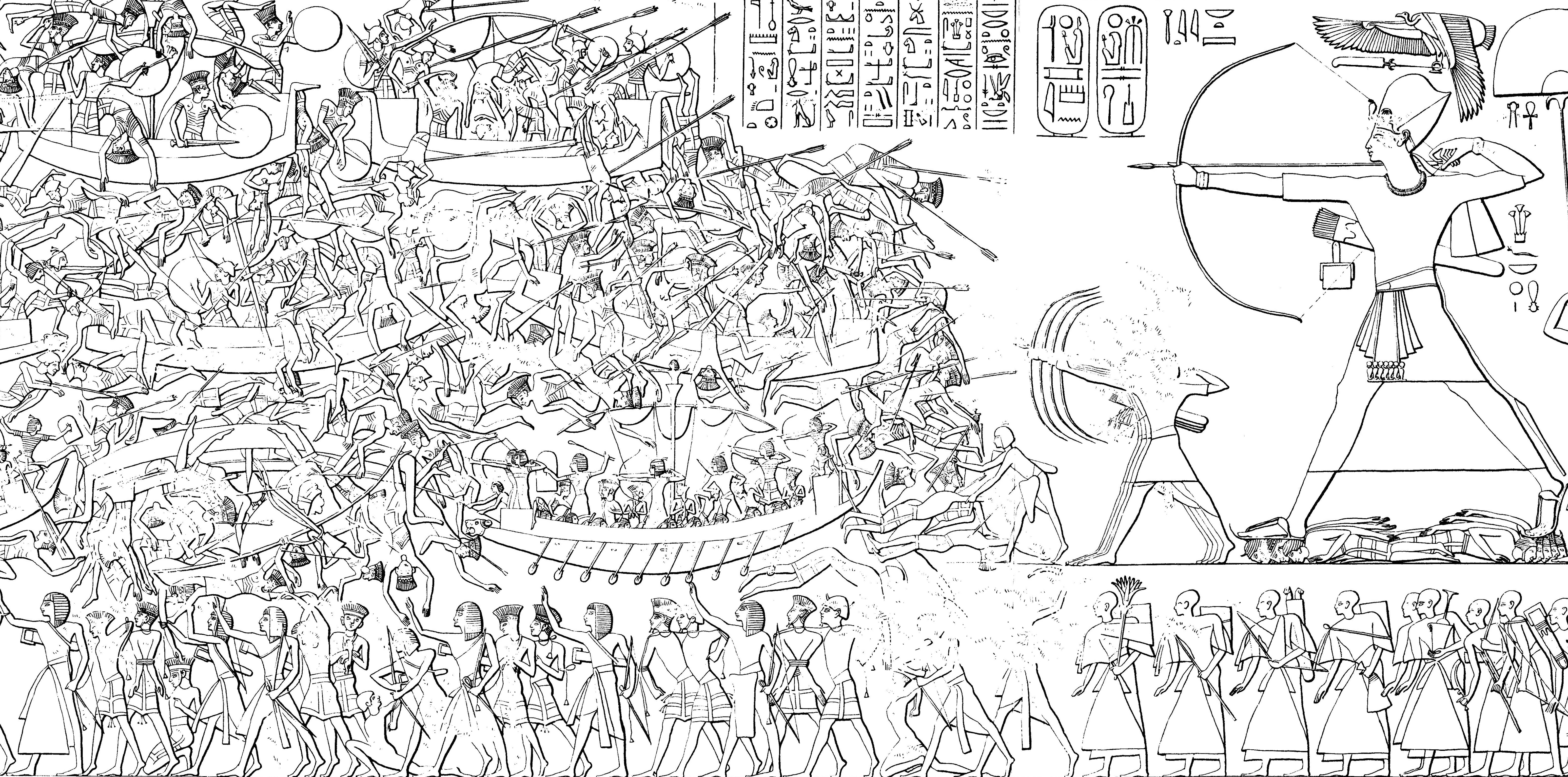|
List Of Nuragic Tribes
This is a list of ancient Corsican and Sardinian tribes, listed in order of ethnic kinship or the general area in which they lived. Some closely fit the concept of a tribe. Others are confederations or even unions of tribes. Overview Before the Roman conquest in the 3rd century BC, the islands of Corsica and Sardinia were inhabited by three main peoples or ethnic groups, the Corsi, the Balares, and the Ilienses, each of them divided into several tribes. With the Roman conquest, the province of Sardinia and Corsica was created, becoming the second province of the Roman Republic to be created after that of Sicily. The ethnic and linguistic affiliation ( Paleo-Sardinian language) of the Nuragic people and tribes remains to be further studied, moreover "Nuragic" might have also been a geographical and historical name designating different peoples and languages, rather than indicating a single origin. Current knowledge indicates that they may have been related to the Iberians a ... [...More Info...] [...Related Items...] OR: [Wikipedia] [Google] [Baidu] |
Tribe
The term tribe is used in many different contexts to refer to a category of human social group. The predominant worldwide use of the term in English is in the discipline of anthropology. The definition is contested, in part due to conflicting theoretical understandings of social and kinship structures, and also reflecting the problematic application of this concept to extremely diverse human societies. Its concept is often contrasted by anthropologists with other social and kinship groups, being hierarchically larger than a lineage or clan, but smaller than a chiefdom, ethnicity, nation or state. These terms are similarly disputed. In some cases tribes have legal recognition and some degree of political autonomy from national or federal government, but this legalistic usage of the term may conflict with anthropological definitions. In the United States (US), Native American tribes are legally considered to have "domestic dependent nation" status within the territorial ... [...More Info...] [...Related Items...] OR: [Wikipedia] [Google] [Baidu] |
Iberian Language
The Iberian language is the language of an indigenous western European people identified by Ancient Greece, Greek and ancient Rome, Roman sources who lived in the eastern and southeastern regions of the Iberian Peninsula in the pre-Migration Era (before about AD 375). An ancient Iberians, Iberian culture can be identified as existing between the 7th and 1st centuries BC, at least. Iberian, like all the other Paleohispanic languages except Basque language, Basque, was extinct language, extinct by the 1st to 2nd centuries AD. It had been replaced gradually by Latin, following the Roman conquest of the Iberian Peninsula. The Iberian language is unclassified language, unclassified: while the scripts used to write it have been deciphered to various extents, the language itself remains largely unknown. Links with other languages have been suggested, especially the Basque language, based largely on the observed similarities between the numeral system, numerical systems of the two. ... [...More Info...] [...Related Items...] OR: [Wikipedia] [Google] [Baidu] |
Ligurian Language (ancient)
The Ligurian language was an ancient tongue spoken by the Ligures, an indigenous people inhabiting regions of northwestern Italy and southeastern France during pre-Roman and Roman times. Because Ligurian is so sparsely attested, its classification and relationship to neighbouring languages has proven difficult, prompting debate among linguists for much of the 20th century. The current scholarly consensus is that Ligurian was likely an Indo-European language or language family, possibly Celtic, or at least influenced by or related to Celtic languages.; ; ; ; ; see for an overview of scholarly opinions on the classification of Ligurian. However, this hypothesis is primarily based on toponymy and onomastics, and on a few glosses given by ancient Graeco-Roman writers (since no Ligurian texts have survived), and thus remains partly speculative due to the scarcity of data. Because of that, some scholars have even cast doubt on the existence of a Ligurian language itself, since it c ... [...More Info...] [...Related Items...] OR: [Wikipedia] [Google] [Baidu] |
Emidio De Felice
Emidio De Felice (Milan, 1918 – Genoa, 1993) was an Italian linguist and lexicographer. He became a university professor in 1963, teaching linguistics at the University of Genoa. Author of Italian language dictionaries, grammar books and latin anthologies, he is mainly known for his research on Italian onomastics. Works * ''La pronuncia del latino classico'', Arona (Varese), Ed. Paideia, 1948. * ''Grammaticae principia : corso di latino per la scuola media'', Palermo, Palumbo, 1960. * ''La preposizione italiana "a"'', Firenze, Sansoni, 1960. * ''La romanizzazione dell'estremo Sud d'Italia'', Florence, L. S. Olschki, 1962. * ''Le coste della Sardegna : saggio toponomastico storico-descrittivo'', Cagliari, Ed. Sarda Fossataro, 1964. * ''Dizionario della lingua e della civiltà italiana contemporanea'', coautore Aldo Duro, Palermo, Palumbo, 1974. * ''Dizionario dei cognomi italiani'', Milan, A. Mondadori, 1978. * ''I cognomi italiani : rilevamenti quantitativi dagli elenchi tel ... [...More Info...] [...Related Items...] OR: [Wikipedia] [Google] [Baidu] |
Celts
The Celts ( , see Names of the Celts#Pronunciation, pronunciation for different usages) or Celtic peoples ( ) were a collection of Indo-European languages, Indo-European peoples. "The Celts, an ancient Indo-European people, reached the apogee of their influence and territorial expansion during the 4th century BC, extending across the length of Europe from Britain to Asia Minor."; . "[T]he Celts, were Indo-Europeans, a fact that explains a certain compatibility between Celtic, Roman, and Germanic mythology."; . "The Celts and Germans were two Indo-European groups whose civilizations had some common characteristics."; . "Celts and Germans were of course derived from the same Indo-European stock."; . "Celt, also spelled Kelt, Latin Celta, plural Celtae, a member of an early Indo-European people who from the 2nd millennium bce to the 1st century bce spread over much of Europe." in Europe and Anatolia, identified by their use of Celtic languages and other cultural similarities.. "C ... [...More Info...] [...Related Items...] OR: [Wikipedia] [Google] [Baidu] |
Proto-Indo-Europeans
The Proto-Indo-Europeans are a hypothetical prehistoric ethnolinguistic group of Eurasia who spoke Proto-Indo-European (PIE), the reconstructed common ancestor of the Indo-European language family. Knowledge of them comes chiefly from that linguistic reconstruction, along with material evidence from archaeology and archaeogenetics. The Proto-Indo-Europeans likely lived during the Late Neolithic period (6400 to 3500 BC). Mainstream scholars place them in the Pontic–Caspian steppe across Eurasia (this steppe extends from northeastern Bulgaria and southeastern Romania, through Moldova, and southern and eastern Ukraine, through the Northern Caucasus of southern Russia, and into the Lower Volga region of western Kazakhstan, adjacent to the Kazakh steppe to the east, both forming part of the larger Eurasian Steppe). Some archaeologists would extend the time depth of PIE to the Middle Neolithic period (5500 to 4500 BC) or even the Early Neolithic period (7500 to 5500 ... [...More Info...] [...Related Items...] OR: [Wikipedia] [Google] [Baidu] |
Ligurians
The Ligures or Ligurians were an ancient people after whom Liguria, a region of present-day north-western Italy, is named. Because of the strong Celtic influences on their language and culture, they were also known in antiquity as Celto-Ligurians. In pre-Roman times, the Ligurians occupied the present-day Italian region of Liguria, Piedmont, northern Tuscany, western Lombardy, western Emilia-Romagna, and northern Sardinia, reaching also Elba and Sicily. They inhabited also the French region of Provence-Alpes-Côte d'Azur and Corsica;Strabo, ''Geography'', book 4, chapter 6Livy, ''History of Rome'', book XLVII however, it is generally believed that around 2000 BC the Ligurians occupied a much larger area, extending as far as what is today Catalonia (in the north-eastern corner of the Iberian Peninsula). The origins of the ancient Ligurians are unclear, and an autochthonous origin is increasingly probable. What little is known today about the ancient Ligurian language is base ... [...More Info...] [...Related Items...] OR: [Wikipedia] [Google] [Baidu] |
Gallura
Gallura ( or ; ) is a region in North-Eastern Sardinia, Italy. The name ''Gallùra'' is allegedly supposed to mean "stony area". Geography Gallùra has an area of . It is from the Italian peninsula and from the French island of Corsica. The coast of Gallura is very jagged and continues along in a continuous series of small fiords, rock-cliffs and little islands that form the archipelago of La Maddalena, a natural bridge towards nearby Corsica. The landscape is characterised by granite rocks and harsh mountains that, even if not particularly high, have constituted for millennia a barrier between this region and the nearby territories of Baronie and Montalbo. Monte Limbara is the highest mountain (1,362 m/4,469 ft). It represents the boundary between Gallura and the nearby region called Logudoro. Its highest peak is Punta Balestrieri (1362 m above the sea level). In the past, Monte Limbara used to be the location of an important NATO long range radar base and a Carabini ... [...More Info...] [...Related Items...] OR: [Wikipedia] [Google] [Baidu] |
Bronze Age
The Bronze Age () was a historical period characterised principally by the use of bronze tools and the development of complex urban societies, as well as the adoption of writing in some areas. The Bronze Age is the middle principal period of the three-age system, following the Stone Age and preceding the Iron Age. Conceived as a global era, the Bronze Age follows the Neolithic, with a transition period between the two known as the Chalcolithic. The final decades of the Bronze Age in the Mediterranean basin are often characterised as a period of widespread societal collapse known as the Late Bronze Age collapse (), although its severity and scope are debated among scholars. An ancient civilisation is deemed to be part of the Bronze Age if it either produced bronze by smelting its own copper and alloying it with tin, arsenic, or other metals, or traded other items for bronze from producing areas elsewhere. Bronze Age cultures were the first to History of writing, develop writin ... [...More Info...] [...Related Items...] OR: [Wikipedia] [Google] [Baidu] |
Sherden
The Sherden (Egyptian: ''šrdn'', ''šꜣrdꜣnꜣ'' or ''šꜣrdynꜣ''; Ugaritic: ''šrdnn(m)'' and ''trtn(m)''; possibly Akkadian: ''šêrtânnu''; also glossed "Shardana" or "Sherdanu") are one of the several ethnic groups the Sea Peoples were said to be composed of, appearing in fragmentary historical and iconographic records (ancient Egyptian and Ugaritic) from the Eastern Mediterranean in the late 2nd millennium BC. On reliefs, they are shown carrying round shields and spears, dirks or swords, perhaps of Naue II type. In some cases, they are shown wearing corslets and kilts, but their key distinguishing feature is a horned helmet, which, in all cases but three, features a circular accouterment at the crest. At Medinet Habu the corslet appears similar to that worn by the Philistines. The Sherden sword, it has been suggested by archaeologists since James Henry Breasted, may have developed from an enlargement of European daggers and been associated with the exploitation o ... [...More Info...] [...Related Items...] OR: [Wikipedia] [Google] [Baidu] |
Sea Peoples
The Sea Peoples were a group of tribes hypothesized to have attacked Ancient Egypt, Egypt and other Eastern Mediterranean regions around 1200 BC during the Late Bronze Age. The hypothesis was proposed by the 19th-century Egyptology, Egyptologists Emmanuel de Rougé and Gaston Maspero, on the basis of primary sources such as the reliefs on the Mortuary Temple of Ramesses III at Medinet Habu (temple), Medinet Habu. Subsequent research developed the hypothesis further, attempting to link these sources to other Late Bronze Age evidence of migration, piracy, and destruction. While initial versions of the hypothesis regarded the Sea Peoples as a primary cause of the Late Bronze Age collapse, more recent versions generally regard them as a symptom of events which were already in motion before their purported attacks. The Sea Peoples included well-attested groups such as the Lukka, as well as others such as the Weshesh whose origins are unknown. Hypotheses regarding the origin of the va ... [...More Info...] [...Related Items...] OR: [Wikipedia] [Google] [Baidu] |







